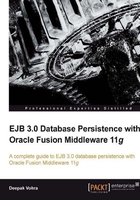
The main objective of the Enterprise JavaBeans (EJB) 3.0 specification is to improve the EJB architecture by reducing its complexity from the developer's point of view. EJB 3.0 has simplified the development of EJBs with the introduction of some new features. The new features include support for metadata annotations, default values for a configuration, simplified access of environmental dependencies and external resources, simplified session and entity beans, interceptors, enhanced support for checked exceptions, and elimination of callback interfaces. The persistence and object/relational model has been revised and enhanced in EJB 3.0. The persistence and object/relational model in EJB 3.0 is the Java Persistence API (JPA). We shall discuss and introduce these new features in this chapter.
Metadata annotations were introduced in JDK 5.0 as a means to provide data about an application. Annotations are used for the following purposes:
- Generating boilerplate code (code that is repeated in different sections of a Java program) automatically.
- Replacing configuration information in configuration files such as deployment descriptors.
- Replacing comments in a program.
- Informing the compiler about detecting errors and generating or suppressing warnings. The
@Deprecatedannotation is used to inform the compiler about a deprecated feature, on detecting which the compiler generates a warning. The@Overrideannotation informs the compiler about an overridden element. If the element is not overridden properly, the compiler generates an error. The@SuppressWarningsannotation is used to inform the compiler to suppress specific warnings. - Runtime processing of annotations by annotating the annotations with the
@Retention(RetentionPolicy.RUNTIME)annotation.
EJB 3.0 specification has introduced some metadata annotations for annotating EJB 3.0 applications. EJB 3.0 metadata annotations have reduced the number of classes and interfaces a developer is required to implement. Also, the metadata annotations have eliminated the requirement for an EJB deployment descriptor. Three types of metadata annotations are used in EJB 3.0: EJB 3.0 annotations, object/relational mapping annotations, and annotations for resource injection and security. Though annotations follow a different semantic than Java code, they help in reducing code lines and—in the case of EJB—increase cross-platform portability. The EJB 3.0 annotations are defined in the javax.ejb package. For example, the @Stateless annotation specifies that an EJB is a Stateless Session Bean:
import javax.ejb.Stateless;
@Stateless
public class HelloBean implements Hello {
public void hello() {
System.out.println("Hello EJB 3.0!");
}
}
For all the new EJB 3.0, annotations, refer to the EJB 3.0 specification document EJBCore (ejb-3_0-fr-spec-ejbcore.pdf). Persistence annotations are defined in the javax.ejb.persistence package. For example, the @Entity annotation specifies that the EJB is an Entity Bean:
import javax.persistence.*;
@Entity
@Table(name = "Catalog")
public class Catalog implements Serializable {
private long id;
@Id
public long getId() {
return id;
}
public void setId(long id) {
this.id = id;
}
}
The resource injection and security annotations are defined in the Common Annotations for the Java Platform specification, and are in the javax.annotation and javax.annotation.security packages. For example, the @Resource injection may be used to inject a javax.sql.DataSource resource. First, configure a data source in a Java EE container. Subsequently, inject a data source handle by annotating a declaration for a variable of type javax.sql.DataSource with the @Resource annotation.
@Resource
private javax.sql.DataSource mysqlDS;
public getCatalogEntry(){
Connection conn = mysqlDS.getConnection();
}
Data source injection using the @Resource annotation precludes the requirement for JNDI lookup using an InitialContext object. The security annotations are presented in the following table.
Annotation Description
DeclareRoles Declares references to security roles
RolesAllowed Declares the methods that are allowed to invoke the methods of the entity bean
PermitAll Specifies that all security roles are allowed to invoke the specified methods.
DenyAll Specifies that no security roles are allowed to invoke the specified methods.
RunAs Specify a security role as the bean's run-as property.